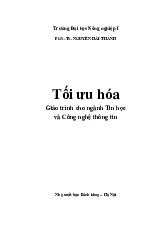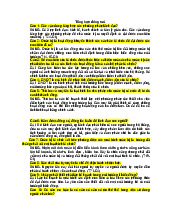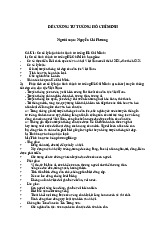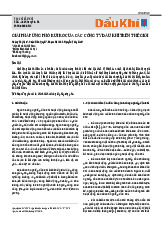


Preview text:
Chapter 21 The Mutual Fund Industry 1
Quantitative Problems Chapter 21
1. On January 1st, the shares and prices for a mutual fund at 4:00 pm are: Shares Stock owned Price 1 1,000 $1.92 2 5,000 $51.18 3 2,800 $29.08 4 9,200 $67.19 5 3,000 $4.51 cash n.a. $5,353.40
Stock 3 announces record earnings, and the price of stock 3 jumps to $32.44 in after-market trading.
If the fund (illegally) allows investors to buy at the current NAV, how many shares will $25,000 buy?
If the fund waits until the price adjusts, how many shares can be purchased? What is the gain to such
illegal trades? Assume 5,000 shares are outstanding.
Solution: At 4:00 pm, the NAV is calculated as: $25,000 buys 128.034 shares.
Based on the new information, NAV is: $25,000 buys 126.813 shares.
If stale prices are used, the investor buys 128.034 shares. $25,000 enters the fund. After
the price increase (assuming nothing else changes), the fund is worth $1,010,683.40. Each
share is worth 1,010,683.40/5128.034 = $197.09. The investor’s shares are now worth
$25,234.20, or a gain of $234.20.
2. A mutual fund charges a 5% upfront load plus reports an expense ratio of 1.34%. If an investor plans
on holding a fund for 30 years, what is the average annual fee, as a percent, paid by the investor?
Solution: 5%/30 = 0.1667%
The expense ratio is an annual charge, so it remains 1.34%.
The total fees paid are 1.34% + 0.1667% = 1.5067%.
3. A mutual fund offers “A” shares which have a 5% upfront load and an expense ratio of 0.76%. The
fund also offers “B” shares which have a 3% backend load and an expense ratio of 0.87%. Which
shares make more sense for an investor looking over an 18 year horizon?
Solution: For the “A” shares, the average annual fee is 5%/18 + 0.76% = 1.0378%
For the “B” shares, the average annual fee is 3%/18 + 0.87% = 1.0367%
So, the investor is better off with the “B” shares.
4. A mutual fund reported year-end total assets of $1,508 million and an expense ratio of 0.90%. What
total fees is the fund charging each year?
Solution: The fees are a percent of total assets. In this case, 0.90% × 1,508 million = $13,572,000.
5. A $1 million fund is charging a back-end load of 1%, 12b-1 fees of 1%, and an expense ratio of
1.9%. Prior to deducting expenses, what must the fund value be at the end of the year for investors to break even?
Chapter 21 The Mutual Fund Industry 2
Solution: With the backend load, the fund value must be (after expenses):
$1 million/0.99 = $1,010,101.01
The expense ratio typically includes 12b-1 fees. So, a total of 1.9% will be charged. So,
before expenses, the fund value must be: 1,010,101.01/0.981 = $1,029,664.64
6. On January 1st, a mutual fund has the following assets and prices at 4:00 p.m.: Shares Stock owned Price 1 1,000 $1.97 2 5,000 $48.26 3 1,000 $26.44 4 10,000 $67.49 5 3,000 $2.59
Calculate the net asset value (NAV) for the fund. Assume that 8,000 shares are outstanding for the fund. Solution:
7. An investor sends the fund a check for $50,000. If there is no front-end load, calculate the new
number of shares and price/share. Assume the manager purchases 1,800 shares of stock 3, and the rest is held as cash.
Solution: With the $50,000, the value of the fund is now $952,380 + 50,000 = $1,002,380. Shares
are sold at a price of $119.05, or 420 new shares. There are now 8,420 shares outstanding. The new fund looks like: Shares Stock owned Price 1 1,000 $1.97 2 5,000 $48.26 3 2,800 $26.44 4 10,000 $67.49 5 3,000 $2.59 cash n.a. $2408
8. On January 2nd, the prices at 4:00 pm are: Shares Stock owned Price 1 1,000 $2.03 2 5,000 $51.37 3 2,800 $29.08 4 10,000 $67.19 5 3,000 $4.42 cash n.a. $2408
Calculate the net asset value (NAV) for the fund. Solution:
9. Assume the new investor then sells the 420 shares. What is his profit? What is the annualized return?
Chapter 21 The Mutual Fund Industry 3
The fund sells 800 shares of stock #4 to raise the needed funds.
Solution: The 420 shares are worth 420 × 122.08 = 51,273.60, for a profit of 1,273.60.
The one day return is 1,273.60/50,000 = 2.54%. Annualized, this is 637% in nominal
terms, assuming 250 trading days. The new fund is: Shares Stock owned Price 1 1,000 $2.03 2 5,000 $51.37 3 2,800 $29.08 4 9,200 $67.19 5 3,000 $4.42 cash n.a. $4,886.40
10. To discourage short-term investing in its fund, the fund now charges a 5% upfront load and a 2%
backend load. The same investor decides to put $50,000 back into the fund. Calculate the new
number of shares outstanding. Assume the fund manager buys back as many round-lot shares of stock #4 with the cash.
Solution: With the upfront load, 5% is charged as a commission. The actual funds invested are $50,000 × 0.95 = $47,500.
This represents $47,500/122.08 = 389.09 new shares.
The manager purchases 700 shares of stock 4.
11. On January 3rd, the prices at 4:00 pm are: Shares Stock owned Price 1 1,000 $1.92 2 5,000 $51.18 3 2,800 $29.08 4 9,900 $67.19 5 3,000 $4.51 cash n.a. $5,353.40 Calculate the new NAV. Solution:
12. Unhappy with the results, the new investor then sells the 389.09 shares. What is his profit? What is the new fund value?
Solution: The 389.09 shares are worth 389.09 × 121.98 = 47,461.20. This amount comes out of the
fund, leaving the fund with $975,847.20.
The investor must then pay the 2% back-end fee, leaving 47,461.20 × 0.98 = 46,511.98.
This represents a loss of 3,488.02, mostly due to fees.
Document Outline
- Shares
- Shares
- Solution:
- Solution:
- Shares
- Solution:




